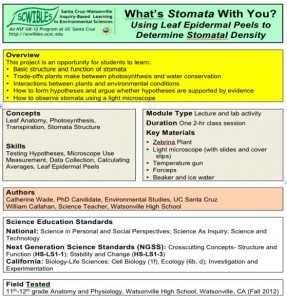Using Models to Observe Correlation and Improve Predictions
by Caleb Bryce, Kim Goetz and Pablo Barrick
In this mini-activity, students measure the masses of specific numbers of beans and graph their data. From their graph they determine a linear model equation. Using their model, they predict the number of beans based on a given mass. The students are asked to create their own model for estimating the number of marbles in a large jar.
Students learn: 1) How to make graphs to depict data and to assess patterns; 2) How correlation can be used to construct a practical model; 3) How to use a model to predict what can not be easily measured; and 4) How to use evidence to support an argument.
Docs: fulltext.pdf
Keywords: argument, evidence, models, patterns, prediction, proportion, scale, systems


 Using Leaf Epidermal Peels to Determine Stomatal Density
Using Leaf Epidermal Peels to Determine Stomatal Density